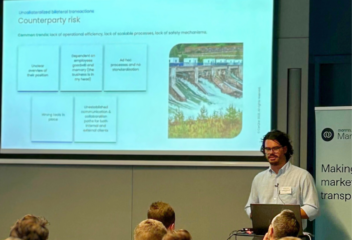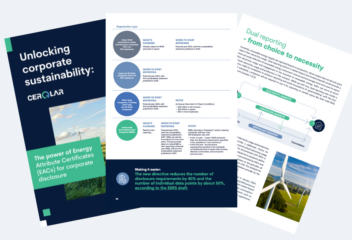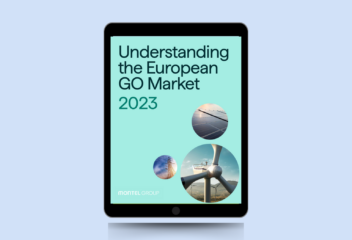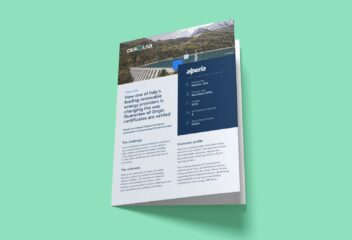Guarantee of origin contract management
The guarantee of origin (GO or GoO) market represents one of the central hubs for renewable energy trading in Europe. In recent years, social changes, the demand for energy, and green legislations have led the market to experience an unprecedented growth that is likely to continue for the foreseeable future. While a growing market has many benefits for traders, producers, and consumers, such as increased demand and higher prices, it also means that market participants need to pause and reexamine whether the current trade process still works for an evolved market.

Managing a broader contract scope and the current GO workflow
Currently, contracts are managed over various complicated exchanges between counterparties. While the GO market was still in its early stages and contracts were mostly simple, managing trades manually on a batch-by-batch basis was possible, if frustrating. But as the GO market has grown in both scope and complexity, manual management leaves the process open to a variety of errors and disadvantages, including:
- Incorrect contract details
- Missed payments on the buyer’s side
- Missed contract delivery on the seller’s side
- Difficulty scaling trade activities to accommodate market growth
- Increased workflow expenses
- Higher chances of data being missed or slipping through the cracks
Additionally, it is extremely challenging and time-consuming to manually review every item traded and ensure it meets contract specifications. This is especially critical in today’s GO market, where what were once minor details, such as the GO certificate’s power source and geographic origin, have become more relevant to trades. The task of doing everything possible to mitigate these challenges is often left to an already overworked and overwhelmed mid-office team that is struggling to manage the scope of increasingly more intricate and vast contracts.
Long-term effects of manual contract management
Managing contracts manually not only leaves each and every trade agreement at risk of human error, but it can also have wider-reaching long-term effects. For example, faulty details in the contract could result in mistaken updates to your portfolio, causing you to trade certificates you don’t have or neglect certificates that you do.
Another long-term effect is that as the market expands and shifts, new GO market trends will emerge, and each trend has the potential to become very lucrative for market participants. To seize the opportunity of these trends, quick and decisive action must be taken as soon as possible, all of which is challenging without an efficient method for contract management in place.
Outdated technology keeps GoO market growth limited
Contracts are an essential part of the GO trade lifecycle, not only outlining agreements but giving the trade participants a way to keep track of the trade details. Ensuring all the complex requirements outlined in the contract are met is critical, and this is impossible if there are flaws in the contract itself. As contracts are often sent back and forth between parties, or terms are agreed on verbally or in other difficult-to-verify forms, it is challenging to ensure that a manual contract remains accurate.
Once an agreement has been made, mid-office staff must manually comb through disorganized spreadsheet portfolios to update and identify which GO certificates are included. This entire process is lengthy, drawn out, and expensive, requiring hours of operation staff’s time, and delaying future trading while leaving all parties at risk of missed or delayed payment or delivery. Since most of the challenges can be traced back to the lack of technological support for a growing market, it’s clear that a technological platform is the only solution.
Supporting market growth with technology
Other markets with comparable trajectories, such as the stock market, evolved gradually over time. But various social and legal factors have led the GO industry to grow suddenly and rapidly without the luxury of having technological infrastructure evolve alongside it organically. As the market grows and becomes more complex, this lack becomes increasingly apparent, and market participants struggle to expand their activities with existing limited infrastructure. One of the most prominent challenges this situation has created is the difficulty in ensuring that information contained in a GO trade contract matches up with the inventory that’s delivered.
The renewable energy market has grown more sophisticated, and within the GO market especially, the specifics of each trade can be extremely consequential. This includes the myriad details listed on each GO certificate, such as the source of the renewable energy, its geographic origin, and more. When dealing with trades involving hundreds, and even thousands of GO certificates, combing through each one manually is an expensive and drawn-out process. This is further complicated when market participants manage their portfolios on various general tools, such as spreadsheets, CRMs, PDFs, or more. Each platform and certificate needs to be carefully examined, and as trades grow in scope, this challenge goes from inconvenient to impossible to potentially limiting.
Simplify your environmental certificates workflow with Cerqlar
CerQlar is the first solution made specifically to address the needs of the GO trading industry. The CerQlar platform allows you to automate your energy certificate workflow and ensure your contract details are both accurately recorded and accurately met for your entire trade lifecycle.
Beginning with capturing your trade details and automatically filling them into customized trade details, CerQlar introduces efficiency into the environmental workflow process by ensuring your contracts are quickly sent to, received by, and signed by the other party. This prevents common errors such as payment delays and miscommunications that lead to losses. With CerQlar, you can automate the entire process, allowing you to engage in complex and more lucrative trades without risking errors or delays.














